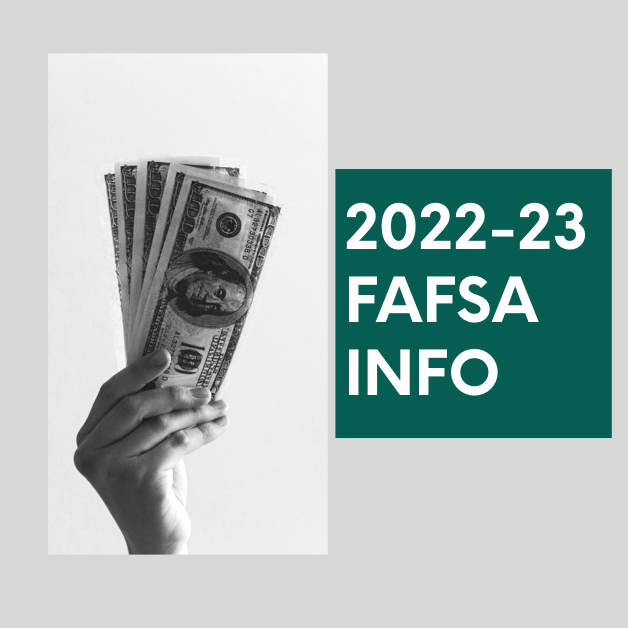
FAFSA, FAFSA, FAFSA. The Free Application for Federal Student Aid (FAFSA) has been the subject of most college prep correspondence this week. It makes sense when you note that the office of Federal Student Aid provides more than $120 billion in grant, work-study, and loan funds each year to help pay for college or career school.
FAFSA is now open and available so colleges are urging families to file the form. It’s important to file the FAFSA but there is a lot of misinformation out there about it. That is why I’m sharing some important things to note about the FAFSA as well as resources to help you complete it.
Noteworthy FAFSA 2022-23 Information
1. The 2022-23 Free Application for Federal Student Aid (FAFSA) is available and ready for you to file online on the Federal Student Aid site. (It has been live since Friday, October 1st.) If you prefer a mobile app, the form is on the myStudentAid app, available on the App Store (iOS) or on Google Play (Android).
You and your dependent student must establish a Federal Student Aid ID (FSA ID) first. You can visit FSAID.ed.gov to create one. It can be used as your electronic signature for the FAFSA and related transactions for future years.
Along with the FSA ID, you will need your Social Security Number or your Alien Registration Number (if you are not a U.S. citizen) and your federal income tax returns, W-2s, and other records of money earned.
In addition, (if applicable) bank statements and records of investments and records of untaxed income are needed to complete the FAFSA.
2. The FAFSA helps to determine your teen’s eligibility for awards and other need-based financial assistance. It is the primary document that the federal government and most schools require before they consider students for federal financial assistance (such as federal grants, scholarships, student loans and work-study programs).
In addition, many colleges use the FAFSA to determine eligibility for additional assistance from state and private sources. That is why the FAFSA is most important in helping to secure as much funding as possible for your teen’s college education.
3. The 2022-23 FAFSA will use 2020 Federal Income Tax Return information. If you are eligible, consider using the IRS Data Retrieval Tool to import your 2020 tax information into the FAFSA.
It is an easy way to provide the necessary data and to make certain that your FAFSA has the correct information. The IRS encrypts the tax information that is transferred to your FAFSA for security.
On a related note…
If your family is experiencing a negative financial impact this year from the COVID-19 pandemic that isn’t reflected on the FAFSA, contact prospective schools directly. They sometimes offer “professional judgments” in special circumstances when there have been significant changes in income or expenses. The judgment allows their team to adjust certain elements on the FAFSA to account for special circumstances that have not been adequately considered.
4. If you haven’t already done so, I encourage you to file your FAFSA right away. Since most schools use the FAFSA to distribute their own school-funded assistance (and some types of school financial assistance are offered on a first-come, first-served basis), fill out the form as early as possible.
You can find federal, college and state FAFSA deadlines on the Federal Student Aid’s FAFSA® Deadlines page but the sooner that you apply, the more time your family will have to make the best college financial plans. Just be sure to include any schools that your teen is considering attending on the form. (Each school has its own FAFSA code.)
5. Even if you don’t believe that your teen will qualify for federal financial aid, complete the FAFSA anyway. You might be surprised by how much aid you’re eligible to receive. Besides, many scholarships and grant programs will still require a FAFSA for consideration anyway.
4 Helpful FAFSA Resources
If you have questions about the FAFSA and/or need help completing the FAFSA, there are several options:
1. Online help is available at the Federal Student Aid site.
2. You can contact the Federal Student Aid Information Center at 1-800-4-FED-AID (1-800-433-3243) and a customer service representative will assist you.
3. Contact the financial aid team at your teen’s prospective college or university.
4. The College Board has partnered with Benefits Data Trust—a national nonprofit—to connect Opportunity Scholarship participants with Wyatt℠, a free around-the-clock FAFSA-assistance chatbot that answers questions via text message.
If your teen hasn’t signed up for the College Board’s FREE Opportunity Scholarship program, consider doing so. Seniors can sign up for Wyatt using the link at the top of the Opportunity Scholarships homepage.
I hope that you found this information useful and that filling out the FAFSA is (relatively) painless for your family!
P.S. In addition to filing the FAFSA, some schools and scholarships also require the College Scholarship Service Profile (CSS Profile).
